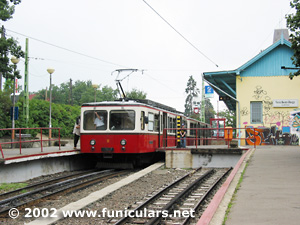|
s
How a funicular works

Cog railway with the cog rail in the center. Fogaskerekü vasút, Budapest..
|
Cog operation
For a conventional railway, running more or less horizontally, low friction between the train's steel wheels and the steel rails is an advantage. The train rolls more freely and thus uses less energy than a vehicle with rubber tires on asphalt.
However, for such a train it is a problem to get up a steep incline. The low adhesion causes the train's wheels to slip, and the train has difficulty making headway. One solution is to operate the railway with cogs. There is a cogwheel on the train's axles, and a "sawtoothed" rail between the running rails. This enables the train to make it up a steep slope by pulling itself up, cog by cog.
But for short distances and really steep inclines, cog operation has limitations, requiring other solutions for those situations.
contents - next page 
© Text och photo: Bruse LF Persson
|